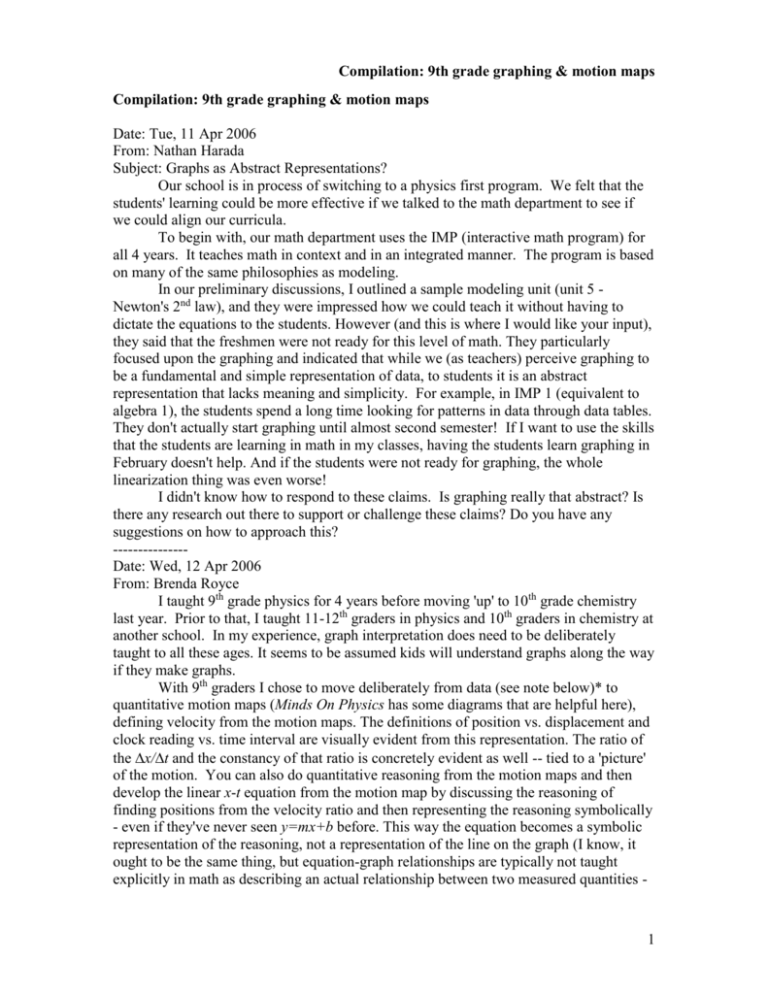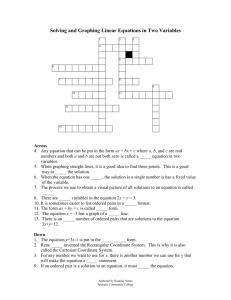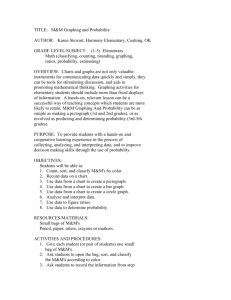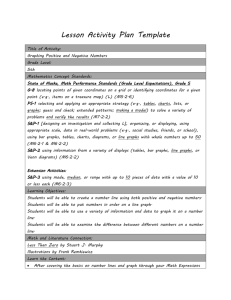Graphing and motion maps in grade 9
advertisement

Compilation: 9th grade graphing & motion maps Compilation: 9th grade graphing & motion maps Date: Tue, 11 Apr 2006 From: Nathan Harada Subject: Graphs as Abstract Representations? Our school is in process of switching to a physics first program. We felt that the students' learning could be more effective if we talked to the math department to see if we could align our curricula. To begin with, our math department uses the IMP (interactive math program) for all 4 years. It teaches math in context and in an integrated manner. The program is based on many of the same philosophies as modeling. In our preliminary discussions, I outlined a sample modeling unit (unit 5 Newton's 2nd law), and they were impressed how we could teach it without having to dictate the equations to the students. However (and this is where I would like your input), they said that the freshmen were not ready for this level of math. They particularly focused upon the graphing and indicated that while we (as teachers) perceive graphing to be a fundamental and simple representation of data, to students it is an abstract representation that lacks meaning and simplicity. For example, in IMP 1 (equivalent to algebra 1), the students spend a long time looking for patterns in data through data tables. They don't actually start graphing until almost second semester! If I want to use the skills that the students are learning in math in my classes, having the students learn graphing in February doesn't help. And if the students were not ready for graphing, the whole linearization thing was even worse! I didn't know how to respond to these claims. Is graphing really that abstract? Is there any research out there to support or challenge these claims? Do you have any suggestions on how to approach this? --------------Date: Wed, 12 Apr 2006 From: Brenda Royce I taught 9th grade physics for 4 years before moving 'up' to 10th grade chemistry last year. Prior to that, I taught 11-12th graders in physics and 10th graders in chemistry at another school. In my experience, graph interpretation does need to be deliberately taught to all these ages. It seems to be assumed kids will understand graphs along the way if they make graphs. With 9th graders I chose to move deliberately from data (see note below)* to quantitative motion maps (Minds On Physics has some diagrams that are helpful here), defining velocity from the motion maps. The definitions of position vs. displacement and clock reading vs. time interval are visually evident from this representation. The ratio of the x/t and the constancy of that ratio is concretely evident as well -- tied to a 'picture' of the motion. You can also do quantitative reasoning from the motion maps and then develop the linear x-t equation from the motion map by discussing the reasoning of finding positions from the velocity ratio and then representing the reasoning symbolically - even if they've never seen y=mx+b before. This way the equation becomes a symbolic representation of the reasoning, not a representation of the line on the graph (I know, it ought to be the same thing, but equation-graph relationships are typically not taught explicitly in math as describing an actual relationship between two measured quantities - 1 Compilation: 9th grade graphing & motion maps the line seems to be seen as the end product, not the relationship). In this sequence, the graph is then the LAST representation they encounter. Once kids understood the connection between motion and motion maps qualitatively and quantitatively, I turned the motion map to a vertical orientation on the page and added a time axis to the right. They then re-plotted the strobe points from the motion map (drawn next to the position axis) over their corresponding time positions and we discussed the connection between the graph, the motion map, and the real motion. They did come to understand graphing reasonably well by working with them in a stepwise fashion and giving the motion map the central place in representing motion. I had them prepare vertical motion maps when beginning with data before they plotted the graph to lock in the connection. This sequence was more rapidly repeated with Unit 3. The funny thing is, when I introduced motion maps at the end of the representational sequence with 11-12th graders, they had locked on to the 'math' representations and didn't really see the point of the motion map (they already had something that got them answers!), and yet they still had some typical difficulty with interpreting graphical representations. This is what first got me thinking the motion map should be introduced first. I'd probably keep this sequence if I ever return to teaching 1112th grade first year physics again. As far as linearization goes, I quit using it with 11-12th graders because they didn't get it well. Too many kids seemed to see it as yet another equation and NOT another way of representing exactly the same information. A statement of proportionality did more (in my experience) to move kids forward with understanding the resulting equation since they saw that as a simpler way of saying the same thing, not a different way. Maybe others know something about teaching kids to linearize graphs; something I missed that makes them more successful than I was. I don't think I'd do this with 9th graders. The v-t graph makes more sense for defining acceleration since the ratio found between v and t is exactly tied to the conceptual understanding of acceleration, where it is not as explicitly evident in the curved x-t graph when graphical interpretation is still being developed. *Note on the motion data: The Unit 2 lab can build a motion map if you have the kids mark positions vs. time on adding machine tape laid down beside the buggy. It produces a permanent record of the original data, and allows discussion of concepts such as motion axis, measurement zero (axis origin), initial position, direction and sign, etc that are useful descriptors of motion and need to be understood to interpret graphical representations. The tapes can be revisited over days as these ideas are built. And they can use the tapes to generate quantitative representations of the motion of their buggies from their original data source as each representation is developed. This helps them see the representations as equivalent since they all describe the exact same buggy run. 2






